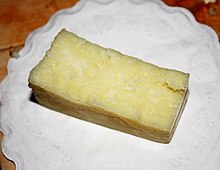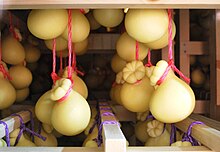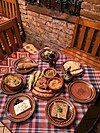Kashkaval
| Kashkaval | |
|---|---|
 | |
| Country of origin | Bulgaria, Romania, Serbia |
| Source of milk | Cow, sheep, buffalo, goat |
| Pasteurised | Traditionally, no |
| Texture | Semi-hard |
Kashkaval[a] is a type of cheese made from cow's milk, sheep's milk or both.[1] In Albania, Bulgaria, North Macedonia, Serbia and Romania, the term is often used to refer to all yellow cheeses (or even any cheese other than sirene). In English-language menus in Bulgaria, kashkaval is translated as "yellow cheese" (whereas sirene is usually translated as "white cheese" or simply "cheese").
Etymology[]

The name kashkaval possibly comes from Latin caseus ('cheese') and caballus ('horse'),[2] by means of the Italian caciocavallo, with the widely accepted explanation that the word cavallo ('horse') comes from the cheese being traditionally dried by attaching two gourd shaped balls of caciocavallo with a single rope and hanging them to a wooden pole as if placed on a horse's back.
Another theory exists. Some researchers from the Faculty of Veterinary Medicine of the University of Belgrade claim the Aromanian population, a native Balkan people, created cașcaval. As in Romanian, the word caș means 'cheese' in Aromanian. Balkan etymology is given for the suffix -kaval in the word kachkaval in the study, nor do the researchers mention the horse, the Latin term caballus or even the Italian term cavallo and instead refer to the seasonal movement of the semi nomadic Vlachs and their livestock between fixed summer and winter pastures (transhumance).[3]
Locality[]
Albania[]
In Albania, kaçkavall is the most popular type of cheese after djathë i bardhë (white cheese). It is considered a traditional Albanian cheese, and is widely used as a side dish. A great majority of traditional restaurants will bring plates of raw or fried kaçkavall for no additional cost before the main dishes finish cooking. All dairy companies in Albania produce kaçkavall and mainly use cow's or sheep's milk.
Bulgaria[]

In Bulgaria, kashkaval is made from cow's milk and is known as kashkaval vitosha, while a variation made from ewe's milk is called kashkaval balkan. Kashkaval preslav is the name given to the cheese made from a mixture of both milks.[1]
Kashkaval is a traditional food used in most of the breakfast pastry. One of the most common dishes with kashkaval is kashkavalka which is a little pastry containing kashkaval inside and on top. Like in the other Balkan countries, it is a major substitute for all other kinds of cheese, especially in pizzas. Another popular Bulgarian snack is princesa (Bulgarian: принцеса; "princess"), which is a grilled slice of bread topped with kashkaval or topped with ground pork meat and kashkaval.
Regional varieties have their distinct properties. For example, kashkaval vitosha is made of cow's cheese, kashkaval balkan is made of sheep's cheese, while kashkaval preslav is made of both.
Israel[]
Kashkaval is one of the most popular types of cheese in Israel, due to the large Jewish population of eastern and southeastern European origins.
Romania and Moldova[]
In Romania and Moldova, cașcaval is used to refer to a number of types of yellow medium and semi hard cheeses made of sheep's or cow's-milk. The best known varieties of cașcaval in Romania are dobrogea (from sheep's milk only), penteleu (from mix of sheep's and cow's milk), dalia and rucăr (both from cow's milk only). But the term is often used by extension as a generic name for all semi-hard yellow cheeses such as the Swiss Emmental cheese, the Dutch Gouda and the British Cheddar, or anything that looks similar to cașcaval.
During the communist regime, because of the food shortages, Romanian housewives developed a technique for a homemade pressed cheese, similar to cașcaval, made out of milk, smântână, butter and eggs.[4] In Romanian cuisine, a lot of dishes are made with cașcaval, like cașcaval pane or mămăligă.
North Macedonia[]

Kashkaval cheese is very popular in North Macedonia. It is mostly made of cow's milk, however both a sheep's milk and a mixed (cow's and sheep's milk) variant is widely available. Kashkaval is also a synonym for any yellow cheese, to the extent that the word "cheese" mostly means white cheese such as feta, while yellow cheeses such as Gouda or Emmental have the suffix kashkaval attached to them in everyday speech, as simpy calling them cheese would be ludicrous, since they're not white cheeses.[citation needed]
Russia[]
Kashkaval cheese is popular in Russia. In addition to the Balkan and Italian products, there exists also a Russian version of kashkaval.[5]
Serbia[]
In Serbia, kačkavalj is traditionally a sheep milk hard cheese, and as such a protected brand of the city of Pirot.[6] Other cheeses, made from a mix of cow and sheep milk, are sometimes also branded as kačkavalj but they cannot be defined as pirotski (of Pirot).
Kačkavalj is one of the six traditional cheeses of Serbia. The production process (in Serbian) can be seen online,[7] and according to a TV show video clip,[8] it was brought to Pirot in the 1810s with the Dalmatian or Italian cheesemakers who settled in then-Ottoman Empire; the cheese was distributed throughout the Balkans (specifically mentioned in the link are Salonica and Istanbul).
Levant[]
In the Levant (Syria, Jordan, Palestine, and Lebanon), qashqawān is widely used as a melting cheese, particularly in pastries. Hungarian-style kashkaval is the most common type found in the region.[9]
Notes[]
References[]
- ^ a b "Kashkaval". cheese.com. Retrieved 26 May 2017.
- ^ "Cașcaval". dexonline.ro (in Romanian).
- ^ Zora Mijačević; Snežana Bulajić (December 2004). "Traditional Manufacturing of Hard Cheese – Kachkaval on Stara Planina Mountain" (PDF). Acta agriculturae slovenica. 84 (1): 11.
- ^ Anghelescu, Șerban, in Anii 80 și bucureștenii, Editura Paideia, Bucharest 2003.
- ^ Carić, Marijana (1999), "Ripened Cheese Varieties Native to the Balkan Countries", Cheese: Chemistry, Physics and Microbiology, Springer, Boston, MA, pp. 263–279, doi:10.1007/978-1-4615-2800-5_9, ISBN 9780834213395
- ^ Caucaso, Osservatorio Balcani e. "Serbia, learning about cheeses". Retrieved 26 May 2017.
- ^ Gale Nikolic (7 July 2009). "Tradicionalna izrada pirotskog kackavalja". Archived from the original on 2021-12-12. Retrieved 26 May 2017 – via YouTube.
- ^ Boris Kostov (24 March 2012). "Pirotski kackavalj". Archived from the original on 2021-12-12. Retrieved 26 May 2017 – via YouTube.
- ^ "Kashkaval Cheese". Kőröstej Csoport.
See also[]
| Wikimedia Commons has media related to Kashkaval. |
- List of cheeses
- List of stretch-cured cheeses
Further reading[]
- Carić M. (1999) Ripened Cheese Varieties Native to the Balkan Countries. In: Fox P.F. (eds) Cheese: Chemistry, Physics and Microbiology. Springer, Boston, MA.
- Cow's-milk cheeses
- Sheep's-milk cheeses
- Stretched-curd cheeses
- Bulgarian cheeses
- Jewish cuisine
- Greek cuisine
- Israeli cuisine
- Macedonian cheeses
- Romanian cheeses
- Serbian cheeses
- Serbian cuisine
- Turkish cheeses
